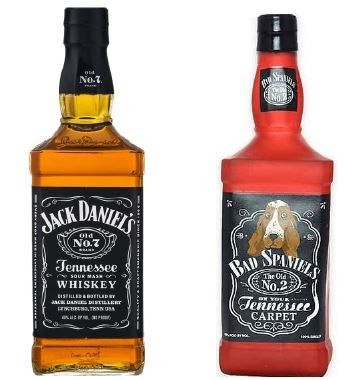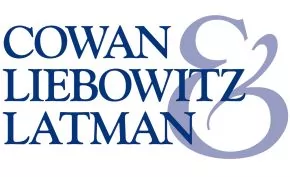
The U.S. Supreme Court unanimously held that VIP Products' "Bad Spaniels" squeaky dog toy parody of the Jack Daniel's whiskey bottle was not shielded from a claim of trademark infringement under the so-called Rogers v. Grimaldi test that provides threshold First Amendment protection for the use of trademarks in expressive works.
The Court further rejected VIP's claim that its use of "Bad Spaniels" was a "noncommercial use" statutorily exempt from claims of trademark dilution.
The Court held that both the Rogers test, whether valid or not, and the noncommercial exception to dilution claims do not apply when, as here, VIP was using "Bad Spaniels" as a trademark to indicate the source of its dog toys. However, the Court remanded the case to the lower courts, to determine whether the courts properly considered the parodic effect of the product in the analysis of Jack Daniel's confusion claims.
Jack Daniel's Properties, Inc. v. VIP Products LLC, No. 22–148 is "about dog toys and whiskey, two items seldom appearing in the same sentence."
VIP made a squeaky, chewable dog toy designed to resemble a bottle of Jack Daniel's whisky, replacing the "Jack Daniel's" trademark with the name "Bad Spaniels" and Jack Daniel's "Old No. 7" mark, as well as the phrase "Tennessee Sour Mash Whiskey" with the phrase "The Old No. 2 On Your Tennessee Carpet." Unamused, Jack Daniel's sued VIP for trademark and trade dress infringement, claiming consumers were likely to be confused that the toy originated from or was licensed by Jack Daniel's, and for trademark dilution, based on associating the whiskey brand with dog poop.
District Court Decision for Jack Daniel's
After a bench trial, the District Court found in favor of Jack Daniel's based largely on surveys purporting to show that consumers mistakenly believed that Jack Daniel's had given permission to VIP to launch the dog toy, and on the court's view that the association between Jack Daniel's and dog excrement would cause Jack Daniel's reputational harm.
Ninth Circuit Reversal for VIP
The Ninth Circuit Court of Appeals reversed, finding that the dog toy was subject to the First Amendment threshold test established by the Second Circuit in Rogers v. Grimaldi, 875 F.2d 994 (2d Cir. 1989). Rogers held that a mark holder cannot succeed on a claim of trademark infringement against an artistic work so long as the mark (1) has "artistic relevance to the underlying work" and (2) does not "explicitly misleads consumers as to the source or the content of the work." Although Rogers involved a claim against the use of a trademark in the title and story of a film, courts have found that other media, including video games and music, may qualify as artistic expression protected by the First Amendment and the Rogers test. If a work qualifies for Rogers protection, the case should be dismissed, and the court need not examine the ultimate question of whether consumers are likely to be confused about the source, sponsorship, or licensing of a challenged product. The Ninth Circuit readily found the dog toy satisfied the Rogers test: "although surely not the equivalent of the Mona Lisa," the dog toy was a work of artistic expression.
The Ninth Circuit also found that Lanham Act Section 43(c)(3)(C)'s exclusion of dilution claims for "noncommercial uses," 15 U.S.C. § 1125(c)(3)(C), applied to VIP's product.
Supreme Court Reversal for Jack Daniel's
On appeal to the Supreme Court, several justices questioned whether the Rogers test was even valid. In a concurring opinion, Justice Gorsuch (joined by Justices Thomas and Barrett), noted "it is not entirely clear where the Rogers test comes from" and "it is not obvious that Rogers is correct in all its particulars."
However, in a unanimous opinion delivered by Justice Kagan, the Court sidestepped that broader issue and narrowly held that, whatever the viability of the Rogers test, it was inapplicable, where the defendant was using the challenged phrase as a trademark to indicate the source of its goods.
Because VIP had admitted in its complaint that it owned the "Bad Spaniel's" trademark and trade dress—a conclusion bolstered by other facts such as its registration of similar toy names as trademarks—it was unable to avail itself of any protection afforded by Rogers.
Nonetheless, recognizing that "a trademark's expressive message—particularly a parodic one, as VIP asserts—may properly figure in assessing the likelihood of confusion," the Court remanded the case to the lower court to determine whether parody should, and in the instant case would, make a difference in the likelihood of confusion analysis.
In her concurring opinion, Justice Sotomayor (joined by Justice Alito) cautioned lower courts from placing too much weight on consumer surveys, especially concerning claims of parody where consumers may mistakenly believe that all parodies require permission from the owner of the mark.
The Court also reversed the Ninth Circuit's holding that VIP's use of trade dress and trademarks like those owned by Jack Daniel's was a "noncommercial" use exempt from dilution claims, relying on the same reasoning that such a defense is unavailable when the challenged designations are used as trademarks to indicate the source of one's goods.
Author's Note
The Supreme Court's decision raises several interesting questions, including:
- What is the future viability of the Rogers test, including its applicability with respect to non-traditional media such as dog toys and other commercial products, in contrast to to traditional media such as films and books?
- If courts do apply Rogers, how will they determine whether the challenged designation is used as a source-indicative mark, especially on pleading or summary judgment motions, where the Rogers test is often applied, including whether the courts will look to cases involving statutory descriptive fair use under Lanham Act Section 33(b)(4), 15 U.S.C. § 1115(b)(4), which also requires that the challenged designation be used other than as a mark?
- How will courts view consumer confusion surveys in cases involving parodies, including if any responses concerning whether the defendant received permission from the brand owner will be discounted, as compared with responses concerning the origin or source of the product?
The content of this article is intended to provide a general guide to the subject matter. Specialist advice should be sought about your specific circumstances.

